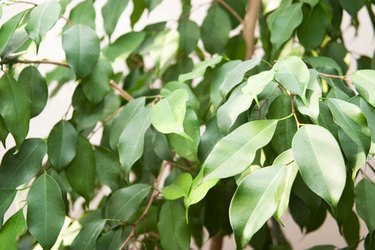
The weeping ficus (Ficus benjamina) is a tropical broadleaf evergreen often grown as a houseplant, the young stems of which are often braided or twisted into other shapes. Although they can be sensitive to their environment, ficus plants are fairly easy to care for indoors. Pruning and repotting may be necessary to keep the plant thriving.
Braided Ficus Tree Characteristics
Video of the Day
In its native habitats in southeast Asia and northern Australia, a weeping ficus tree can reach heights of up to 50 feet. As a houseplant, however, a braided ficus tree is usually 2 to 10 feet tall. Its size can be easily maintained with regular pruning.
Video of the Day
One of the most attractive features of the weeping ficus is its glossy, dark green, oval-shaped leaves, which are around 4 inches long. The trunk is light gray. While this is a flowering tree in the wild, a braided ficus tree is unlikely to bloom indoors.
The weeping ficus tree is considered toxic to dogs and cats.
Ficus Plant Care
Indoor ficus trees need to be watered regularly when they are actively growing. However, it is important to allow the soil to dry out between waterings to prevent root rot. Good drainage is also key to preventing this potentially fatal disease. You can significantly reduce watering during autumn and winter. Braided ficus trees respond well to hard pruning, though a recently pruned plant should be watered less often.
Ficus benjamina trees perform best when kept at warm temperatures. They prefer nighttime temperatures between 65 and 70 degrees Fahrenheit and daytime temperatures between 75 and 85 degrees Fahrenheit. Indirect light is preferable for ficus trees; however, plants kept in humid environments will tolerate direct sunlight and the more humidity, the better.
When actively growing, braided ficus plants will benefit from monthly feedings with a liquid fertilizer. Cleaning the leaves with warm water from time to time will keep the plant looking its best. It may also be necessary to repot a ficus plant if it becomes too large, as this may inhibit foliage development. Winter and early spring are the best times to repot a braided ficus tree.
Indoor Ficus Tree Problems
Houseplants, including ficus trees, rarely suffer from serious diseases indoors. However, indoor ficus trees will drop leaves in response to stress, whether it's too much or too little water, insufficient light or a change of location. If you keep your plant outdoors during the summer, be sure to place it far from heat vents when you bring it inside for the winter, as this too will result in leaf drop.
Like other houseplants, ficus trees can become infested with pests, including spider mites, which tend to become a problem in dry conditions. Small, sap-sucking insects, like scale, mealybugs and aphids, are also known to attack indoor ficus trees, so it's a good idea to check for these pests before bringing outdoor plants inside.
Infested ficus trees should be isolated to prevent the pests from spreading to other plants. In some cases, scale, mealybugs and aphids can be scraped off the leaves or removed with rubbing alcohol. Severely infested ficus trees may need to be discarded.